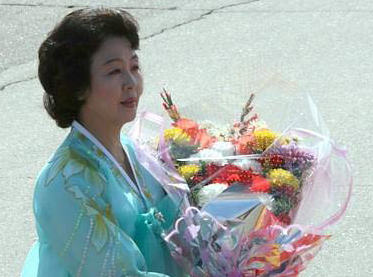时事经纬
06-10-09
盖茨:美军不会撤离阿富汗
盖茨说,白宫将决定今后将采取的步骤,以此确定如何赢得对阿富汗境内塔利班激进分子的战争。盖茨说,奥巴马总统在这一问题上的决定将是他总统任期内作出的最重要决策之一。
温家宝同金正日会谈
金正日表示,实现半岛无核化是金日成主席的遗训,朝方致力于实现半岛无核化的目标没有改变。通过朝美双边会谈,朝美之间的敌对关系必须转变为和平关系。朝方愿视朝美会谈情况,进行包括六方会谈在内的多边会谈。
温家宝对朝方坚持半岛无核化目标、坚持通过包括六方会谈在内的多边对话实现这一目标表示赞赏。温家宝表示,中方愿与朝方及其他有关各方共同努力,为实现半岛无核化、维护东北亚地区和平、稳定和发展作出积极贡献。
“卖花姑娘”女主角洪英姬献花温家宝
美国愿在六方会谈框架下与朝鲜谈判
国务院发言人凯利10月5日表示,美国及其他六方会谈参与国都希望与朝鲜进行对话,但是这一对话的目的必须是实现朝鲜半岛的彻底无核化。他表示,美国仍愿意在六方会谈的框架内与朝鲜进行双边对话,以说服朝鲜开始切实的去核进程。凯利说,美国、中国、俄罗斯、日本和韩国都仍然认为实现朝鲜半岛无核化是六方会谈最核心的目标,也是各国与朝鲜接触的最关键目标,而六方会谈是实现朝鲜半岛无核化的最佳途径。
分析:金正日愿重返六方会谈的言论意在拉拢中国
金正日在5日与中国国务院总理温家宝举行会谈时提到愿意视美朝双边对话的进展重返六方会谈。据分析金正日此番言论是为了拉拢作为六方会谈主席国的中国,稳固主导美朝对话的基础。金正日提到的“和平关系”具体内容无从知晓,但可能包括将《朝鲜停战协定》转变为和平协定,以及绘制面向邦交正常化的蓝图。朝鲜真正重返六方会谈,回到无核化进程还面临很大障碍。预计美朝对话也将遭遇一番曲折。
习近平将出访欧洲五国
习近平将对比利时、德国、保加利亚、匈牙利和罗马尼亚五国进行正式访问。
俄罗斯创业艰难失业严重加剧社会动荡
经济危机使俄罗斯的失业率居高不下,从而导致俄罗斯面临更严重的酗酒、犯罪等社会问题。由于投资经商气候未能改善,在俄罗斯创业经商以及创造新的工作岗位仍然非常困难。
全俄罗斯民意调查中心几个月前的民意调查显示,由于俄罗斯的投资经商气候未能改善,在俄罗斯创业经商,以及创造新的工作岗位仍然非常困难。
全俄民意调查中心领导人费多罗夫说;“我们询问工商界人士,问他们如何在俄罗斯工作,阻挠他们生意发展的障碍是什么,什么因素能够帮助他们,我们期望类似的民意调查能定期进行,并从中能抓住某种趋势和方向。”
费多罗夫说,在俄罗斯最难的是从零开始创业。其次是俄罗斯法律对私有财产的保护非常不好。接下来是贿赂和贪污腐败,再接下来是企业和经商方面的法律不健全以及税务负担十分沉重。
俄罗斯健康和社会发展部部长戈利科娃最近警告说,从今年春季开始的失业率略有下降的现像带有季节性的特点,政府不能因此放松。她预计,2009年俄罗斯的失业人数将达到6百30万人,这能占俄罗斯有劳动能力人口数量的8.3%。明年的失业人数将会再增加50万人,达到6百80万人。
美国能源部官员:中国将成为电动车时代的领导者
美国能源部长助理David Sandalow近日在北京出席一个新能源论坛上发表讲话说,中国电动车产业发展非常迅速,如果美国政府不对电动车产业和相关技术研究投入巨资的话,中国将毫无意外地成为电动车时代的领导者。他说,发展电动车产业是美国能源政策的一个重点,不过中国在发展电动车发面投入的资金更多,也更有进取心。
他说:“如果美国政府不对电动车产业和技术发展投下巨资的话,将很快就被中国超越。”“我相信中美双方都能够从对方身上学到很多东西,如果双方合作全世界都将因此受益。”
为了减少对进口石油的过度依赖中国政府鼓励发展电动车产业,并推出了许多优惠鼓励政策。中国最大的电动车生产商比亚迪公司(BYD
Corp)表示,计划从明年开始在美国市场上销售全电力驱动的汽车。
通用汽车公司和美国其他几家汽车工业也都在积极研发电动车,通用公司上周宣布计划在印度市场上投放一款全新设计的纯电力驱动车。
David Sandalow透露,中美能源合作将成为奥巴马总统11月份访华时的重要议题。
澳大利亚加息25个基点,至3.25%
澳大利亚央行(Reserve Bank of
Australia)周二自2008年3月以来首次上调利率,成为二十国集团(G20)中第一个开始退出经济刺激措施的央行。正是经济刺激政策的作用才帮助该国经济走出全球金融危机的阴霾。
澳大利亚央行今日谨慎加息25个基点,至3.25%。此举证明自2008年9月发生震惊全球的雷曼兄弟(Lehman
Brothers)破产事件以来,人们对全球经济前景的信心不断增强,澳大利亚的经济表现也可圈可点。
澳大利亚央行行长Glenn
Stevens在加息后发布的声明中暗示,随著利率水平日趋正常化,今日的决定可能将拉开一系列加息行动的序幕。
经济学家们预计,澳大利亚央行将在年底前进一步加息。而这一预期在金融期货市场中也开始得到体现。
Stevens称,由于预计经济环境非常疲软且经济面临显著的下行风险,澳大利亚央行曾在2008年末和2009年初多次下调利率。
但他指出,随著未来一年经济增长可能接近趋势水平,通货膨胀接近目标,澳大利亚经济严重萎缩的风险目前也已经消除,因此,央行货币政策委员会认为,从现在开始逐步取消刺激性货币政策是明智之选。
澳大利亚央行宣布利率决定后,澳元大幅走高。
格林威治时间0750,澳元兑美元报0.8865美元,高于决定公布前的0.8769美元。
澳大利亚央行的加息决定也是存在风险的。
商业团体警告称,利率上升以及随之而来的、对更多加息的忧虑将可能对经济复苏构成羁绊,令失业现象更加严重。
澳大利亚房地产协会(Housing Industry Association)首席经济学家Harley
Dale称,消费者信心和商业信心对经济复苏前景至关重要,而加息将会削弱这种信心,这便是隐藏在加息背后的巨大风险。
澳大利亚国库部长韦恩·斯万(Wayne Swan)在堪培拉对记者表示,暂时仍需要扩张性政策为经济提供支撑。
他说,必须确保财政政策与货币政策的紧密结合。虽然目前经济状况有所改善,但全球经济前景依然脆弱。
澳大利亚国库部秘书长Ken
Henry近期表示,澳大利亚失业率要等到2010年底才会见顶。而澳大利亚央行却在此时迫不及待地宣布加息。
澳大利亚是过去一年中经济未陷入衰退的唯一一个发达国家,这在一定程度上得益于澳大利亚央行以前所未有的速度放宽货币政策,加上政府公共开支给经济以大力提振。
Australia Raises Key Interest Rate
The Reserve Bank of Australia had eased rates by a combined 4.25
percentage points in a series of rapid-fire moves after the September
2008 collapse of Lehman Brothers, helping Australia become one of the
few industrialized countries to avoid a major slump over the past year,
and to bounce back more quickly than in the United States and Europe.
On Tuesday, the central bank began to reverse the process, raising its
key cash rate to 3.25 percent from 3 percent, the lowest level in
decades, which had been in force since April.
The central bank’s move contrasts with the stance at other central banks
around the world – including the European Central Bank, the Federal
Reserve and the Bank of Japan – which are all expected to keep their
cost of borrowing at ultra-low levels for some time amid concerns that
the recovery in those countries remains both feeble and fragile.
“This is the first central bank in the Group of 20 world to hike
interest rates, following on the heels of Israel, which was the first
central bank to kick of the global tightening cycle,” said Frederic
Neumann, a regional economist at HSBC in Hong Kong, in a note.
The move, he added, “raises the chance that other central banks will
follow suit perhaps sooner than anticipated. First on the list is Korea
and we see a greater chance now of a hike this quarter rather than the
next, with Taiwan, perhaps surprisingly, coming next in Asia.”
Most analysts had expected the central bank to hold off raising rates
for at least another month, but the governor, Glenn Stevens, cited
Australia’s better- than-expected recovery for the move on Tuesday.
Recent data have shown Australia’s jobs market, house prices and
consumer and business sentiment were all improving rapidly.
“Economic conditions in Australia have been stronger than expected and
measures of confidence have recovered,” in part thanks to various
government stimulus measures and policy initiatives, Mr. Stevens said in
a statement.
The central bank also said the Australian economy was likely to return
to “trend” growth levels, which economists put at around 3.5 percent, in
2010. That is an improvement from a relatively gloomy forecast of 2.25
percent, issued in august, a move that surprised some analysts.
“In the space of a month, they’ve raised their growth forecasts by more
than 1 percent; that’s huge,” said Bill Evans, the chief economist of
Westpac Banking Corp. “But nothing has happened in the past month that
would justify that sort of an increase. It does come as a bit of a
surprise.”
The Reserve Bank of Australia had repeatedly stated that its decision to
slash rates to 3.0 percent was an “emergency” response. Facing a stormy
global outlook, the bank slashed rates by a full percentage point in
February, and then a further quarter of a percentage point in April
before adopting a wait-and-see approach for five months.
“I think they now realize that they went too far and their forecasts for
the labor market, business investment and growth were profoundly too
pessimistic,” Mr. Evans said. “They’re basically saying that we cut too
far in February, now we’re going to have to take it back.”
In addition, Australia’s economy has been helped by its proximity to
Asia’s emerging economic powerhouses, noticeably China, which is widely
expected to grow 8 percent or more this year despite the global
downturn.
While recovery is generally expected to be modest in the major
countries, said Mr. Stevens, the central bank chief, “prospects for
Australia’s Asian trading partners appear to be noticeably better.
Growth in China has been very strong, which is having a significant
impact on other economies in the region and on commodity markets. For
Australia’s trading partner group, growth in 2010 is likely to be close
to trend.”
Craig James, the chief economist at Commsec, the trading arm of the
Commonwealth Bank of Australia, said the Reserve Bank’s decision was a
clear sign that the center of gravity for Australia’s economy was
shifting.
“The Reserve Bank paid a lot of attention to China in the statement
today, focusing on prospects for Asian trading partners. It hasn’t
mentioned Europe, Japan or the United States once,” he said. “With China
expanding strongly, that’s good news for us down under, because our two
economies will be very much linked over the coming decades because China
relies on our resources.”
Dollar Falls on Report Gulf States May Stop Using Greenback
|